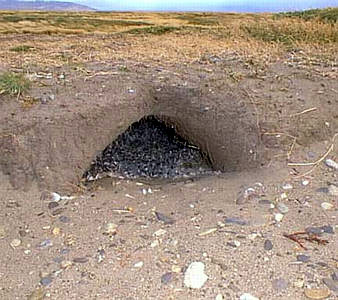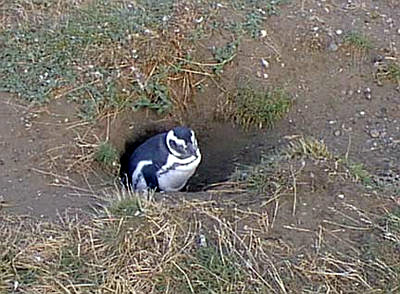
|
|
26 March, 1999
March 26, 1999
Hi from Punta Arenas! I had a really great day today. It started off with
a solo excursion into town, so that I could make reservations for the tour
to the penguin colony. Afterwards, I walked around town for quite a while
. . . taking pictures, buying goodies, and trying to find some souvenirs.
I returned to the ship for lunch, and then went back to town for a little
while. Our trip to the Magellanic penguin colony started at 4:00. We
piled into a van, and rode for about 90 minutes in order to reach the
colony. We ended up north of Punta Arenas, but on a body of water that is
still referred to as the Strait of Magellan (the "strait" is actually a
series of waterways connecting the Atlantic and Pacific Oceans . . . our
ship just traveled through the widest part of the strait). On the way, we
saw some rheas on the side of the road. Rheas are large birds that look
similar to ostriches. We also saw some very small foxes that were really
cute.
The penguins live in burrows, as I explained in yesterday's journal. There
was a trail that you could follow that went past hundreds and hundreds of
these burrows. Throughout most of the area, the penguins were either
hiding inside or standing next to their own burrow. We had a great time
trying to take the "perfect" pictures during the two hours that we walked
amongst the penguins. There was also a lookout area over the water and we
could see groups of penguins coming back from a day of fishing. In about
two or three more weeks, the Magellanic penguins will be migrating north
for the winter -- only to return to this same area next spring.
So, did you figure out the answer to yesterday's question, "Who's the last
scientist that needs to be introduced?" It's me, Kim Giesting. I was born
in Columbus, Ohio, in 1961. During my sophomore year in high school, we
moved to Freeport, Illinois, where I graduated in 1979. It was in high
school that I first started to enjoy science. I have wanted to teach for
as long as I can remember, but I chose to teach science as a result of my
science classes at Freeport High School. I went to Ball State University,
in Muncie, Indiana, because the program for teachers at BSU was highly
recommended. I graduated with my B.S. in Science Education in 1983, and I
graduated with my M.A. in 1985 with a double major in Biology and
Environmental Science.
I began teaching at Connersville High School in 1985, and I've taught there
ever since. While at CHS, I met my husband Marvin, who teaches Chemistry
and Physics. We were married in June of 1987. After teaching for a few
years, I was asked to develop a course in Earth/Space Science. I took
additional college classes to add Earth/Space Science to my license.
Later, I ended up taking several summer workshops in some of the individual
Earth/Space Science disciplines -- specifically in Meteorology, Astronomy,
and Oceanography. It was after these workshops that I began teaching
Astronomy and Oceanography at Connersville High School as one semester
electives. Usually, I teach Astronomy, Oceanography, Earth/Space Science,
and Environmental Science courses.
As most of you know, this is my second trip to Antarctica. Last year, I
was one of five teachers selected from across the United States to
parcticipate in a National Science Foundation program called Teachers
Experiencing Antarctica and the Arctic (TEA). I was paired with Dr. John
Anderson, of Rice University, for a six week expedition to Antarctica. The
program paid for all of my expenses with Dr. Anderson, and it also paid my
school for the cost of a substitute teacher. We were conducting similar
research last year, but we remained in the Ross Sea area and didn't travel
around to the Antarctica Peninsula. In addition to helping with the
research, I also communicated with classrooms via email and sent back daily
journals and digital pictures. Dr. Anderson was already planning a return
trip to Antarctica when we left the continent last year. He invited me to
parcticipate . . . and agreed to cover my expenses out of the money in his
research grant!
Although the offer was generous, I would not have been able to miss two
months of classroom teaching for a second year in a row. It was the result
of a second award that things were able to work out for this year's return
trip to Antarctica. I was selected as the 1998 Indiana Teacher of the
Year. In addition, the Governor of Indiana signed a bill last year
declaring that the Indiana Teacher of the Year has a one year sabbatical
from the classroom. The options for that sabbatical include either
attending a state university as a full-time student or working for the
Indiana Department of Education. I chose the latter option, and my job as
"Ambassador for Education" includes working with the State Science
Coordinator and also giving speeches and presentations all over the state
of Indiana. The Superintendent of Public Instruction, Dr. Suellen Reed,
and my colleagues at the Indiana Department of Education have allowed for
my return to Antarctica with Dr. Anderson.
In addition, the Indiana Department of Education has encouraged me to speak
to children in various schools about Antarctica and this expedition.
Between August and January, I gave nearly 100 such presentations. Once I
return home, I will continue doing this for the remainder of the school
year. While here, I've answered over 300 email questions from students and
others across the United States who have been following the daily journals
and enjoying the digital pictures. This has been an exceptional
opportunity, and I'm so glad that all of you have chosen to parcticipate.
There's only one journal entry left. I'll write it after I return to
Indiana, and it should be posted sometime on Sunday. Until then . . .
Kim Giesting
Latitude: 53 degrees 10 minutes South
Longitude: 70 degrees 54 minutes West

Here's one of Magellanic penguins that we saw today.

Here's a look inside the burrow of a Magellanic penguin. Can you see all of the white feathers inside the burrow?

This Magellanic penguin is sitting inside of its burrow.
Contact the TEA in the field at
.
If you cannot connect through your browser, copy the
TEA's e-mail address in the "To:" line of
your favorite e-mail package.
|
